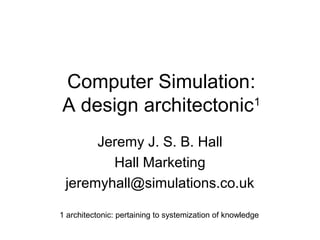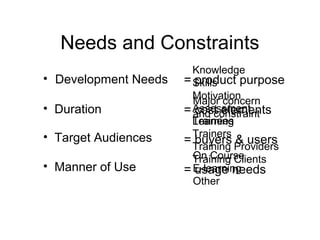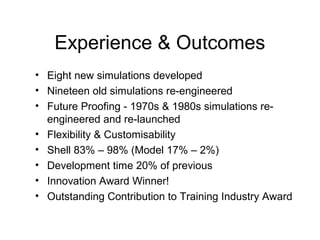Innovation process
- 1. Computer Simulation: A design architectonic1 Jeremy J. S. B. Hall Hall Marketing jeremyhall@simulations.co.uk 1 architectonic: pertaining to systemization of knowledge
- 2. Introduction ? Micro business ? Create & Provide Computer Simulations for management development & business training ? Simulations that place business people in charge of a simulated company
- 3. Background Early 1990ĄŊs decided to re-engineer my simulations to: ? Better meet training needs ? Speed development ? Future-proof my designs Needed way to structure my work
- 4. The Architectonic Needs and Core Values Constraints Design Elements Architectural Elements Architecture Outcomes
- 5. Needs and Constraints Knowledge ? Development Needs = Skills product purpose Motivation Major concern ? Duration = Assessment cost elements and constraint Trainees Learning ? Target Audiences Trainers = buyers & users Training Providers On Course Training Clients ? Manner of Use = E-learning usage needs Other
- 6. Core Values (learner & trainer viewpoints) ? Effective Learning Link to ? Development Needs ? Audience ? Efficient Learning Needs vs Duration ? Manner of Use Audience Viewpoints Constrained by duration Effective Delivery ? Consistent Learning CF academic teaching Every learner on every course provide touchstones
- 7. Design Elements Goodness perceptions ? Simulation Model = Purpose needs product Cognition ? Delivery Dynamics = Affection use product Workload Administration ? Tutoring Needs = Facilitationneeds human Learning Management Development Needs ? Diversity Learners:range needs = knowledge & experience Trainer Skills Manner of Use
- 8. Architectural Elements Lean design based on ? Simulation Model = market needs pull rather market orientation than realism push. Economic Calibration ? Delivery Process Ramped Complexity = Tutor System product dynamics Help Intervention FeedbackScreening Decision Style ? Tutor Support = Explanations ancillary services Comments Different: TutorĄŊs Audit Needs ? Development ? Multiple Versions = Team Commentary differentiation ? Trainer Requirements ? Manner of Use ? Markets
- 10. Experience & Outcomes ? Eight new simulations developed ? Nineteen old simulations re-engineered ? Future Proofing - 1970s & 1980s simulations re- engineered and re-launched ? Flexibility & Customisability ? Shell 83% ĻC 98% (Model 17% ĻC 2%) ? Development time 20% of previous ? Innovation Award Winner! ? Outstanding Contribution to Training Industry Award
- 11. Summary 1. Analyse and define Market Needs ? Product purpose ? Customer cost elements ? Users and Buyers ? Usage needs 1. Extract & summarise Core Values 2. Explore product, dynamics, usage & variety 3. Translate into architecture 4. Develop Products
- 12. Jeremy J. S. B. Hall Hall Marketing Phone 020 7537 2982 E-mail jeremyhall@simulations.co.uk Web www.simulations.co.uk from knowledge through simulated experience to wisdom












